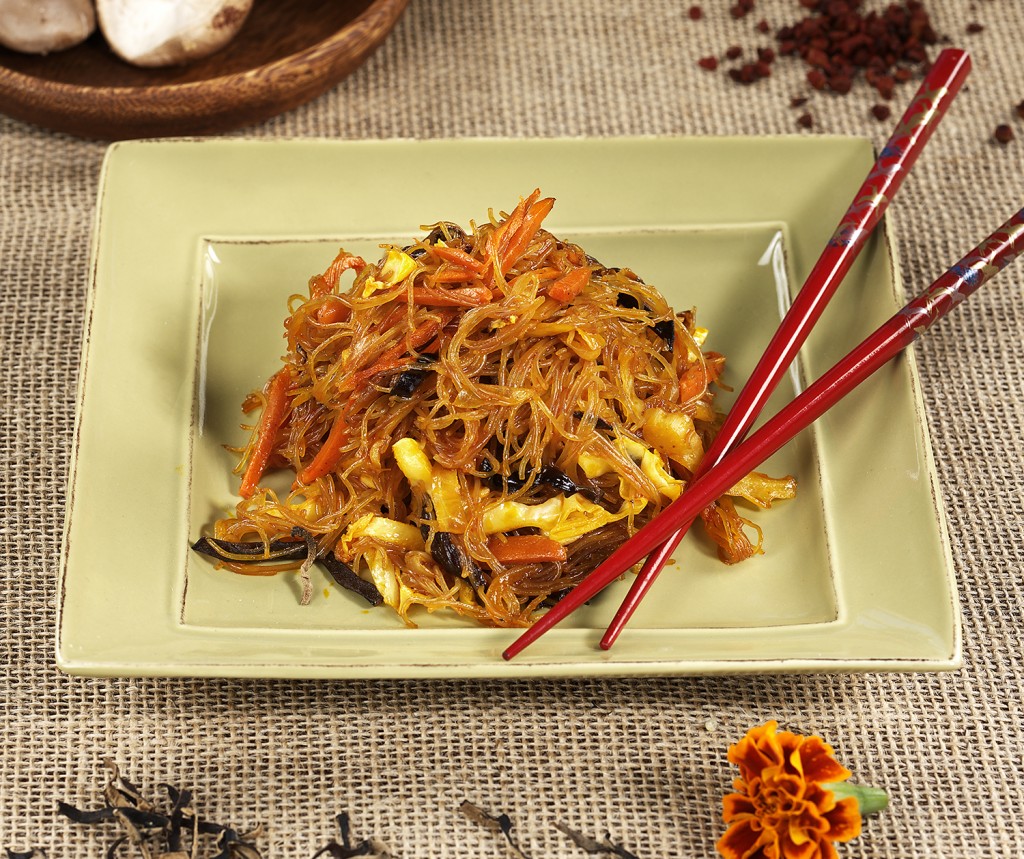Let’s Celebrate the Year of the Dragon!

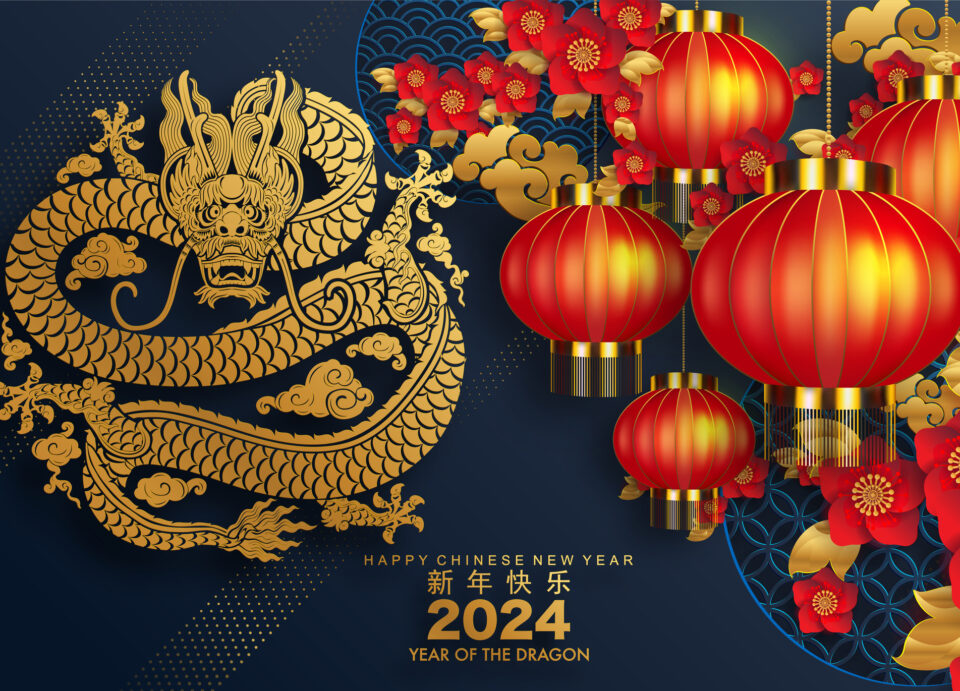
Lunar New Year, also known as Chinese New Year, is a very important holiday for me. Although I was born and raised in Southeast Asia, my father was three-quarters Chinese and my mother was half Chinese. We always celebrated the lunar new year by making special meals full of symbolism. For instance, we made a sweet sticky rice cake called tikoy because it symbolizes unity and togetherness and good luck that is supposed to stick to you all year long.
We also cleaned the house and bought new clothes to wear on New Year’s Eve and New Year’s Day. And my parents gave us children red envelopes stuffed with a little bit of money. The money symbolized prosperity, health, and good luck for the year. We put the red envelopes under our pillows and slept on them for 3 days. Then, to follow tradition, the envelopes are folded into a triangle shape with the money still inside and kept safe for the rest of the year to ensure prosperity.
One of the things I love about Chinese New Year is that it’s usually about six weeks after Christmas (starting sometime between January 27 and February 20) when the days are short and sometimes gloomy, even in Southern California. It’s a bright, festive holiday with emphasis on family, friends and great food.
Lunar New Year’s date changes every year since it follows a lunar calendar. This year the New Year begins on Saturday, February 10, and will culminate with the Lantern Festival on Saturday, February 24. Last year was the Year of the Rabbit but in 2024, it’s the Year of the Dragon. There are 12 animals in the Chinese zodiac, all associated with certain character traits, and the featured animals alternate on a yearly basis.

Throughout Chinese history, the dragon has represented good luck, justice, prosperity and strength, he explains. People born in the year of the dragon are seen as charismatic, intelligent, confident, powerful, naturally lucky and gifted.
While we associate Western New Year’s with adult parties, drinking and football, Chinese New Year is also all about gathering to enjoy lots of food. Chinese communities all over the world from London to Malaysia, Hong Kong and the Philippines celebrate with family and friends.
I typically celebrate Lunar New Year with a dinner for friends and family at Capital Seafood in Arcadia, but this year I am hosting lunch for my guests.. Capital Seafood is one of the dim sum and Chinese food staples in Southern California, and it’s one of my favorite venues for an Asian-style banquet.
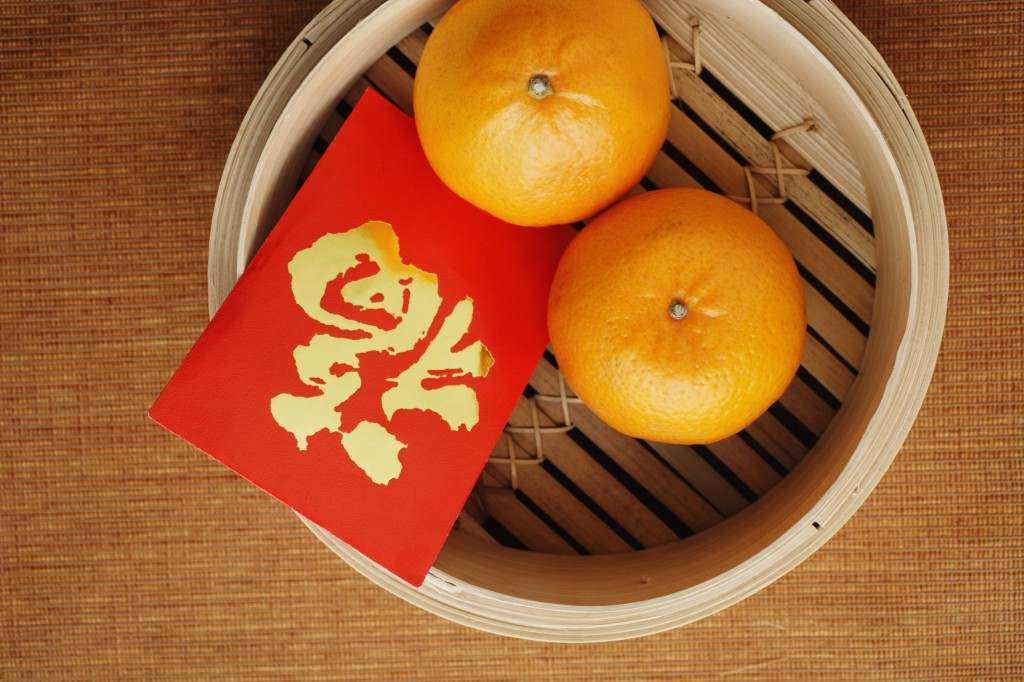 I work with owner Stephanie Lee to create a menu that includes dim sum appetizers like Crab Meat Maw Soup, Honey Walnut Shrimp, House Special Live Lobster, Chef’s Special Stir-Fried Angus Short Ribs, Deep Fried Sole with Sweet Chile Sauce, Crispy Chicken with Minced Garlic, Pea Leaves with Garlic, and Dried Scallop & Egg White Fried Rice. For dessert, the restaurant usually prepares Osmanthus Sesame Mochi in Sweet Wine. Yummy!
I work with owner Stephanie Lee to create a menu that includes dim sum appetizers like Crab Meat Maw Soup, Honey Walnut Shrimp, House Special Live Lobster, Chef’s Special Stir-Fried Angus Short Ribs, Deep Fried Sole with Sweet Chile Sauce, Crispy Chicken with Minced Garlic, Pea Leaves with Garlic, and Dried Scallop & Egg White Fried Rice. For dessert, the restaurant usually prepares Osmanthus Sesame Mochi in Sweet Wine. Yummy!
Capital Seafood also makes artisanal tikoy, those wonderful sticky glutinous rice cakes along with daikon radish cakes. I also request long life noodles with chicken. It’s a dish eaten more often on birthdays than the New Year, but I like the symbolism of long life and health. Stephanie usually makes the noodles for me with lobster sauce instead of the brown sauce they normally come tossed in. I like it better that way.
One of the most important parts of Chinese New Year celebrations is the feasting: On Lunar New Year’s Eve, the extended family would join around the table for a meal that included as the last course a fish that was symbolic of abundance and therefore not meant to be eaten.
In the first five days of the Lunar New Year, people eat long noodles to symbolize long life. On the 15th and final day of the Lunar New Year, round dumplings shaped like the full moon were shared as a sign of the family unit and of perfection.
Here are some of the foods we’ll enjoy and their meanings:
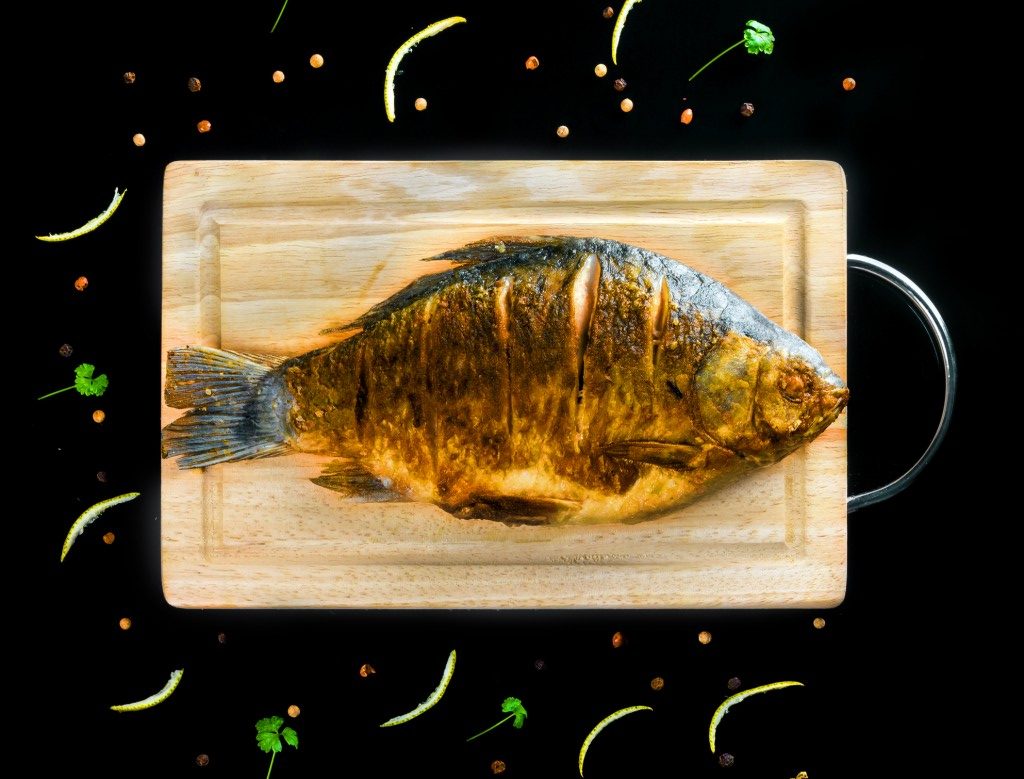 Fish for prosperity — In Chinese, the word “fish” sounds like “surplus,” and having a surplus at the end of the year is a good thing. Not only is the type of fish important—carp and catfish, for example have names that sound like good things for the new year—but the way the fish is eaten matters. The fish is always served at the end of the meal. The head should face distinguished guests or elders, which represents respect, and diners can enjoy the fish only after the one who faces the fish head eats first. The challenging part is that the fish shouldn’t be moved. This makes for some sometimes awkward, sometimes hilarious reaching across the large round banquet table! The two people who face the head and tail of fish should drink together, because this is considered to be lucky.
Fish for prosperity — In Chinese, the word “fish” sounds like “surplus,” and having a surplus at the end of the year is a good thing. Not only is the type of fish important—carp and catfish, for example have names that sound like good things for the new year—but the way the fish is eaten matters. The fish is always served at the end of the meal. The head should face distinguished guests or elders, which represents respect, and diners can enjoy the fish only after the one who faces the fish head eats first. The challenging part is that the fish shouldn’t be moved. This makes for some sometimes awkward, sometimes hilarious reaching across the large round banquet table! The two people who face the head and tail of fish should drink together, because this is considered to be lucky.
Dumplings – Classic Chinese dumplings for the New Year are made to look like silver ingots and symbolize wealth. The dumplings are made of an elastic dough and filled with minced meat and vegetables. The more pleats in the dough, the better. If the seal is too flat, it can mean poverty. To make the dumplings extra lucky, people sometimes put a white thread inside for long life. Sometimes a copper coin is placed in the dumpling and the person who eats it will become wealthy.
Spring rolls – These also represent wealth, because when the meat- and vegetable-filled thin wrappers are fried they look like gold bars. People say, “A ton of gold,” before eating spring rolls as a wish for prosperity.
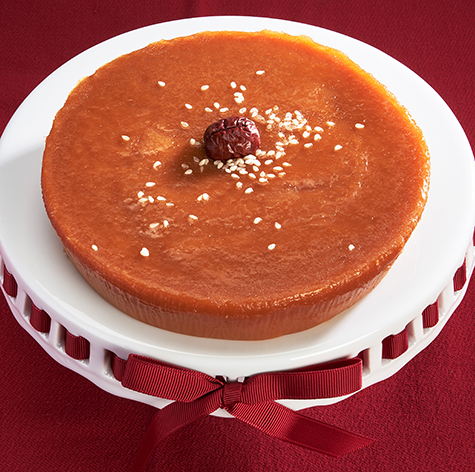
Sweet Rice Cake
Glutinous rice cake: Higher income or position, growth of children and the promise of a better year — Usually eaten as a dessert, glutinous rice cakes can contain sugar, sesame seeds, red dates and water as the main ingredients. Different regions in China have different versions.
Sweet rice balls: Family togetherness — People toast them with, “Happy family reunion.” These are also a dessert and are sometimes filled with fruit preserves, sesame paste or red bean paste.
Citrus fruits – Because they are round and golden in color, they represent fullness and wealth. This is fortunate, because January and February are prime times for all varieties of citrus and they are at their sweet and juicy best. The Chinese word for “orange” sounds like the word for “success,” and one of the ways of writing “tangerine” contains the character for luck. Eating pomelos and shaddocks (similar to pomelo) is thought to bring continuous prosperity.
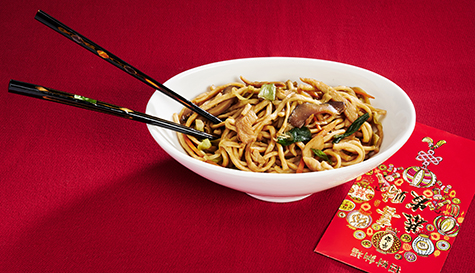 Noodles – These symbolize happiness and longevity. It’s important to serve the noodles long and uncut for long life. They are longer than normal noodles, either fried and served on a plate, or boiled and served in a bowl with their broth.
Noodles – These symbolize happiness and longevity. It’s important to serve the noodles long and uncut for long life. They are longer than normal noodles, either fried and served on a plate, or boiled and served in a bowl with their broth.
There are several noodle recipes in my book, The Age Beautifully Cookbook. To start the Lunar New Year on a healthy note, my Vegetarian Stir-Fry Noodles with Annatto is a little bit out of the ordinary, but delicious and full of FoodTrients.
These colorful noodles, which are made with my Annatto Oil and Annatto Water, are as delicious as they are healthful. They can be served as a main course, appetizer, or side dish. I use flat rice noodles like the kind used to make Pad Thai. You can substitute other varieties of mushrooms, and almost any cabbage will work—Napa, savoy, bok choy, green, or even red—and use store-bought vegetable broth instead of homemade. This is a gluten-free dish, so I use tamari sauce instead of soy sauce. Bragg Liquid Aminos provides even more flavor. If you’re not worried about gluten, you can use chow mien noodles or vermicelli.
Annatto contains vitamin E for beautiful hair, skin, and nails. Annatto’s brilliant color comes from carotenoids, antioxidant pigments that help protect cells from ultraviolet damage. Annatto is also rich in tocotrienols, a special form of vitamin E that has cholesterol-lowering and antioxidant properties.
Shiitake and wood ear mushrooms are good sources of selenium, which lowers cancer risk and boosts immune function. Shiitakes also contain lentinan, which has anticancer properties. Cabbage is a cancer-fighter thanks to its indoles (sulfur compounds), which also make keratin in nails, hair, and skin.
Vegetarian Stir-fry Noodles with Annatto
Serves 6–8
Ingredients
¼ cup Annatto Oil (recipe below)
½ cup julienned white onion
1 tsp. minced garlic
1 cup julienned shiitake mushrooms
½ cup julienned wood ear mushrooms
4 cups Vegetable Stock
¼ cup Annatto Water (recipe below)
1 cup julienned cabbage
¼ cup julienned carrots
2 Tbs. low-sodium tamari sauce
1 Tbs. Bragg Liquid Aminos
Salt or salt substitute and freshly ground black pepper to taste
8 oz. rice or cornstarch noodles (or chow mien or vermicelli)
Lemon wedges, as garnish
Procedure
- In a large pan, sauté the onion and garlic in the Annatto Oil over medium heat for 3–5 minutes.
- Add the mushrooms, vegetable stock, and Annatto Water and bring to a boil.
- Add the carrots, cabbage, sauces, and spices and cover the pan. Reduce the heat to low and simmer for 10–15 minutes or until the carrots are tender.
- Add the noodles and simmer another 3–5 minutes or until they are transparent.
- Remove from the heat, toss thoroughly, and garnish with the lemon wedges.
Chef’s Note: To make this dish heartier, add 1 cup of organic, free-range chicken breast strips to the pan when you add the mushrooms. If you use dried mushrooms instead of fresh ones, just soak them first in hot water for 15–20 minutes or until they are soft.
Annatto Oil and Annatto Water
You can store Annatto Oil in the refrigerator for up to a month and Annatto Water for up to a week.
Annatto Oil
Yields ½ cup
Ingredients
½ cup annatto or achiote seeds (whole, not ground)
½ cup olive oil
Procedure
- Heat the seeds and oil in a pan over low heat for about 5–7 minutes or until the oil turns a bright reddish-orange color. The seeds will sizzle and turn dark, but do not let them turn black and burn.
- Strain to remove the seeds.
Annatto Water
Yields ½ cup
Ingredients
½ cup annatto or achiote seeds (whole, not ground)
½ cup warm water
Procedure
- Add the seeds to the water and let soak for 5 minutes.
- Work the seeds with your hands for a couple of minutes until the water turns orange.
- Strain to remove the seeds.
